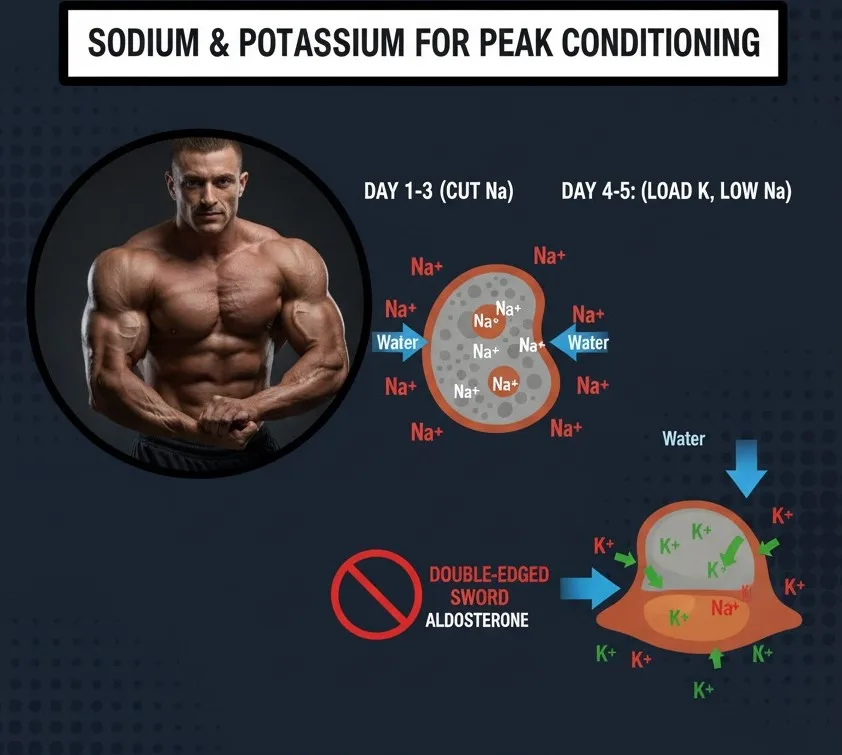The final days before a bodybuilding competition are a masterclass in physiological manipulation, with the strategic control of sodium and potassium being one of the most crucial and delicate maneuvers. The goal is to achieve a maximally "dry" and "full" look, pushing water out from under the skin and into the muscle cells.
The Core Principle: Water Follows Electrolytes
To understand the strategy, you must first understand the fundamental rule of fluid balance: Water always follows electrolytes.
Your body's water is divided into two main compartments:
-
Intracellular Fluid (ICF): Approximately 70% of your body water, located inside the muscle and other cells. The primary electrolyte here is Potassium (K+).
-
Extracellular Fluid (ECF): Approximately 30% of your body water, located outside the cells (including the blood plasma and the interstitial space right under the skin). The primary electrolyte here is Sodium (Na+).
The goal of pre-contest manipulation is to decrease ECF water (to get rid of the "watery" or "puffy" look) and increase ICF water (to make muscles look bigger and denser).
Why Restrict Sodium Before a Show?
Bodybuilders severely restrict or cut sodium intake in the final days (the "peak week") to intentionally disrupt the natural electrolyte balance.
-
Lowering ECF Concentration: Restricting sodium lowers the plasma sodium concentration. Since water moves from a lower concentration to a higher concentration, this effectively causes water to shift out of the ECF space. The result is a drier, harder look.
-
Driving Water Into the Muscle: By maintaining or even increasing potassium intake relative to the now-restricted sodium, the intracellular space (muscle cell) becomes comparatively more concentrated. The body then pulls water into the muscle cell to compensate for this new, higher Potassium-to-Sodium ratio, making the muscles appear fuller and more vibrant.
The outcome of successful sodium manipulation is a body that is dry (veins visible) and has voluminous, pumped muscles.
The Aldosterone Trap: A Two-Edged Sword
While strategic sodium restriction is powerful, it is also a two-edged sword. The body sees a sudden, severe drop in sodium as a threat to its blood volume and pressure, which triggers a powerful counter-regulatory response via the hormone Aldosterone.
The Aldosterone Mechanism:
-
When the body detects low sodium, the kidneys release the hormone Aldosterone.
-
Aldosterone's job is to instruct the kidneys to intensely reabsorb sodium back into the bloodstream and, in exchange, excrete potassium.
The Catastrophic Result:
If the sodium restriction is too prolonged or too severe, the Aldosterone response can ruin the entire plan by:
-
Reversing the Fluid Shift: The body holds onto sodium again, bringing water back into the ECF (under the skin), leading to a soft, watery, or puffy appearance.
-
Muscle Flatness and Fatigue: A prolonged lack of plasma volume and excessive potassium loss can cause the muscles to look flat and lose their vibrancy. It can also lead to electrolyte imbalances that disrupt proper muscle contraction, causing fatigue and an inability to perform on stage.
The Key to Success: Timing and Personalization
All the art in peak week comes down to timing—you must execute the sodium depletion and potassium loading before Aldosterone fully kicks in and destroys the conditioning.
The Crucial Takeaway:
The most important factor is an intelligent Sodium-to-Potassium intake ratio (often aimed in a range such as 1:3 to 1:5 or more in favor of potassium) implemented over a very short-term duration. This protocol must be personalized to the individual's metabolism, body weight, and response to fluid changes to avoid the two-edged sword of Aldosterone.

